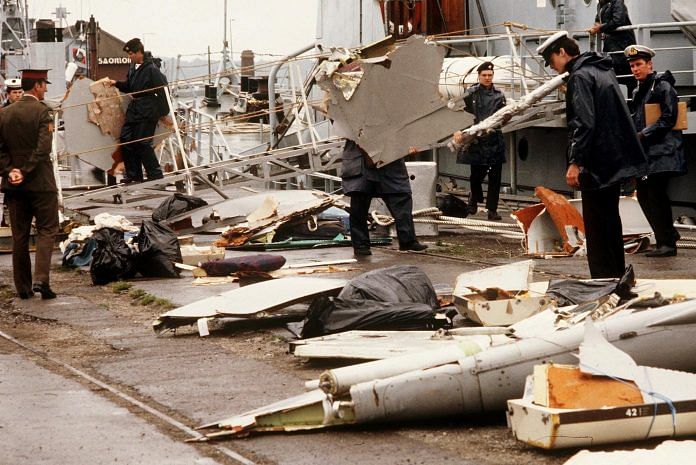Sikh extremism in Canada has been in the news lately, but the Kanishka bombing particularly loomed over Justin Trudeau’s visit to India
New Delhi: On the 33rd anniversary of the Kanishka bombing that put a strain on the India-Canada relationship for decades, ThePrint takes a looks at what happened on that fateful June day.
When Canadian Prime Minister Justin Trudeau visited India several reporters asked him about Sikh gurudwaras in Canada putting up posters of Talwinder Singh Parmar, considered to be the mastermind behind the horrific Air India Flight 182 bombing in 1985, commonly known as the ‘Kanishka tragedy’.
“I do not think that we should ever be glorifying mass murderers, and I am happy to condemn that,” Trudeau said at the event.
Although Trudeau had formally apologised on behalf of the Canadian government for the Komagata Maru incident, there hasn’t been one for Flight 182 yet.
Air India Flight 182
Air India Flight 182 took off from Montreal in the early hours of 23 June 1985. The final destination was Mumbai, with stops at London and New Delhi. It was a Boeing 747, named ‘Emperor Kanishka’.
Around 0715 GMT, the plane was cruising at 31,000 feet over Irish waters when a bomb detonated in the carriage.
All 329 people on the plane — 268 Canadians (mostly of Indian descent), 27 Britons and 24 Indians — died. This was the worst aviation attack in history until 9/11.
The militants had actually planned to conduct two simultaneous bombings on two Air India flights going to India from Canada in opposite directions. The other bomb, that flew over the Pacific, was destined for a flight to Bangkok, but detonated at Tokyo’s Narita airport, killing two baggage handlers. The reason it didn’t detonate in flight was because the planners had forgotten to account for Daylight Saving Time.
Inquiry report
Justin Trudeau’s predecessor and former Canadian Prime Minister Stephen Harper in 2006, had announced a full public inquiry into, what he termed the “worst mass murder in Canadian history”.
The inquiry report concluded that “a cascading series of errors” by the Royal Canadian Mounted Police and the Canadian Security Intelligence Service had led to the terrorist attack on Flight 182. It also said that Parmar and the Babbar Khalsa, a Sikh separatist group, were behind the attacks.
A 20-year trial that cost 130 million Canadian dollars, brought to light several lapses, security errors, and unheeded warnings.
A revenge plot
In the aftermath of Operation Blue Star and the anti-Sikh riots of 1984 following Indira Gandhi’s assassination, the movement for a separate Sikh nation of Khalistan intensified.
Parmar had migrated to Canada, and was wanted by the Interpol for his part in the Khalistani militancy since the early 1980s. Shortly after Operation Blue Star, Parmar paid a visit to auto mechanic and electrician Inderjit Singh Reyat, which is where the revenge plot that became the Flight 182 bombing purportedly began.
In a few months, Reyat openly bought explosives, timers, circuits, and detonators, and even conducted bomb trials in dense forests, right under the nose of the CSIS, who were said to be keeping a watch on him.
Though at least eight people were suspected to be involved, including Parmar, Reyat was the only one convicted. He refused to name any others or testify against them.
Canada’s 9/11
A day before the bombing, on 22 June, Reyat bought 12 volt batteries, and asked for a friend’s car to deliver some things to the airport.
Later, a man called “Manjit Singh” called the airlines to ask whether his ticket on Flight 182 was confirmed; he was told that he was on the waiting list. This man, then, asked for his Samsonite suitcase to be checked into this flight regardless.
On the same day, the X-ray machine had broken down at the Montreal airport and security was using the PDD-4 hand-held explosive sniffer. They were told that the sniffer would emit loud screams near explosives. A soft beep was heard near a red suitcase, but it was allowed to pass, since security personnel were not told what to do when the sniffer emitted soft noises.
There was tight security and extra policemen at the airport on Air India’s request, after threats from Sikh militants.
However, these weren’t the only warnings. Earlier in 1984, at least two informers as well as a man called Harmail Singh Grewal had notified the CSIS and RCMP about potential flight bombings. These reports were dismissed as unreliable.
Justice done?
Reyat’s trial began in 1990, after he was extradited from the UK on Canada’s request. He spent almost 30 years in jail, pleading guilty to manslaughter. On 16 February 2016, Reyat walked free in Canada.
Parmar was considered to be the mastermind behind the attacks, but never convicted. In 1992, he was killed by Indian security forces.
The RCMP and CSIS were severely indicted by investigation reports for failing to join the dots and prevent the bombings, as well as for dismissing crucial evidence afterwards.
This article was originally published on 22 February 2018.



